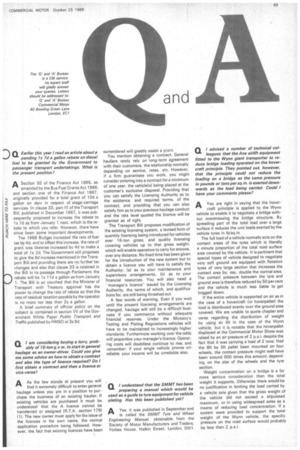advised a number of technical col leagues that the Ace
Page 71

If you've noticed an error in this article please click here to report it so we can fix it.
airlift equipment fitted to the Wynn giant transporter to reduce bridge loading operated on the hovercraft principle. They pointed out, however, that the principle could not reduce the loading on a bridge as the same pressure in pounds or tons per sq.in. is exerted downwards as the load being carried. Could I have your comments please?
AYou are right in saying that the hover
craft principle is applied to the Wynn vehicle to enable it to negotiate a bridge without overstressing the bridge structure. By spreading part of the total load over a large surface it reduces the unit loads exerted by the vehicle tyres in Ibisq.in.
The full load of a vehicle normally acts on the contact areas of the tyres which is literally a minute proportion of the total road surface area covered by the vehicle. It is pertinent that special types of vehicle designed to negotiate very soft ground are equipped with flotation tyres of very large section that increases the contact area by, say, double the normal area. The contact pressure between the tyre and ground area is therefore reduced by 50 per cent and the vehicle is much less liable to get bogged down.
If the entire vehicle is supported on air as in the case of a hovercraft (or hoverpallet) the load is distributed evenly over the ground area covered. We are unable to quote chapter and verse regarding the distribution of weight by using air lift in the case of the Wynn vehicle, but it is notable that the hoverpallet displayed at the Commercial Motor Show was raised by an air pressure of 2 p.s.i. despite the fact that it was carrying a load of 2 tons. Had the 8ft by 5ft pallet been mounted on four wheels, the contact pressure might well have been around 500 times this amount, depending on the size of the wheels and the tyre section.
Weight concentration on a bridge is a far more serious consideration than the total weight it supports. Otherwise there would be no justification in limiting the load carried by a vehicle axle given that the gross weight of the vehicle did not exceed a stipulated maximum, or in using widespread axles as a means of reducing load concentration. If a system were provided to support the total weight of the Wynn vehicle, the specific pressure on the road surface would probably be less than 2 p.s.i.
















































































































